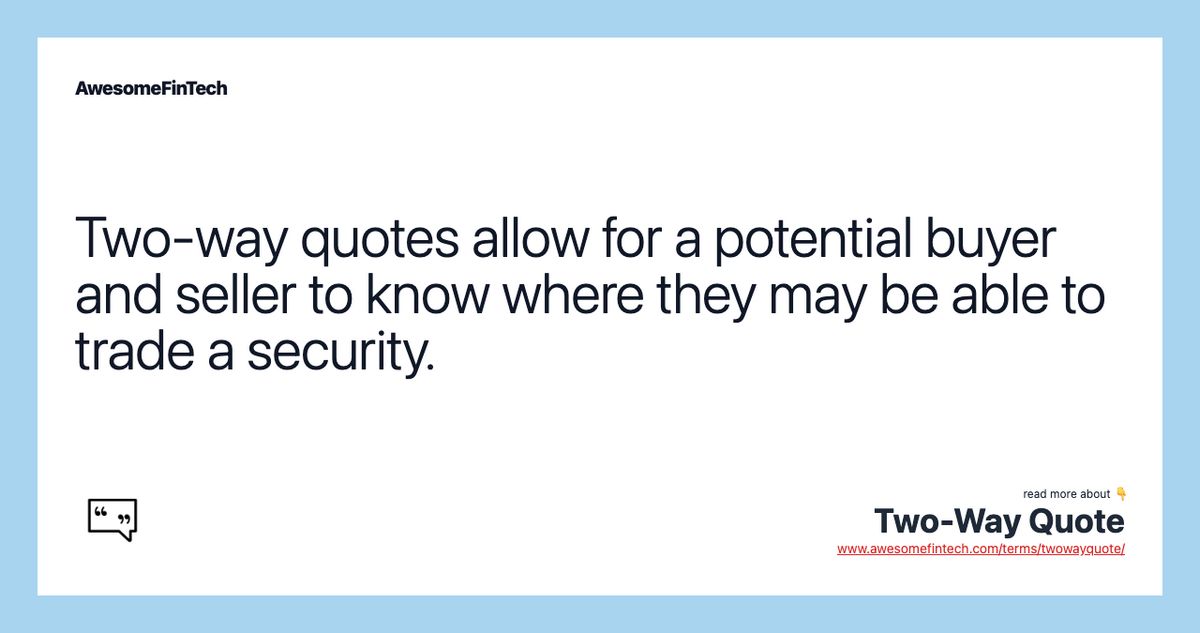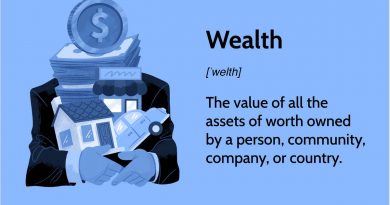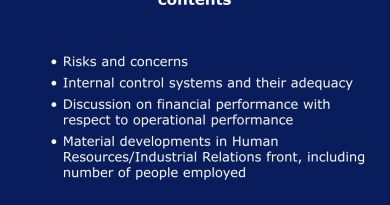Two-Way Quote What it is How it Works Different Types

Contents
Two-Way Quote: What it is, How it Works, Different Types
What Is a Two-Way Quote?
A two-way quote indicates both the current bid price and the current ask price of a security during a trading day on an exchange. To a trader, a two-way quote is more informative than the last-trade quote.
A two-way quote involves a bid-ask spread, or the difference between the highest price a buyer is willing to pay for an asset and the lowest price a seller is willing to accept.
Two-way quotes can be contrasted with one-way quotes, which provide only either the bid side or the ask side.
Key Takeaways
- A two-way quote shows both the current bid price and the current ask price, reflecting the bid-ask spread in a market.
- Two-way quotes allow for potential buyers and sellers to know where they may be able to trade a security.
- These quotes are conveyed as bid followed by the offer.
- Sellers can hit the bid of the quote; buyers can lift the offer (ask).
Understanding a Two-Way Quote
A quote is the price at which an asset can be traded; it may also refer to the most recent price that a buyer and seller agreed upon and at which some amount of the asset was transacted. A two-way quote tells traders the current price at which they can buy or sell a security. Moreover, the difference between the two indicates the spread, giving traders an idea of the current liquidity in the security.
A smaller spread indicates greater liquidity. Enough shares are available at that moment to meet demand, causing a narrowing of the gap between the bid and ask.
Two-way price quotations are often conveyed as $X/$Y when written, or "$X bid at $Y" when spoken.
Here’s an example of a two-way quote for a stock: Citigroup $62.50/$63.30, or "$62.50 bid at $63.30." This tells traders that they can currently purchase Citigroup shares for $63.30 or sell them for $62.50. The spread between the bid and ask is $0.80 = ($63.30-$62.50).
A one-way quote, or one-sided market, occurs when market makers only quote either the bid or the ask price. This condition can arise when the market is moving strongly in a certain direction or if volatility increases suddenly.
About the Bid-Ask Spread
Whether the quote involved is in stocks, bonds, futures contracts, options, or currencies, the bid-ask spread is the difference between the price quoted for an immediate sale or purchase. The size of the bid-offer spread is one measure of the liquidity of the market and the size of the transaction cost. If the spread is zero, the security is called a frictionless asset.
Market makers are professional traders who offer to sell securities at a given price (the ask price) and will also bid to purchase securities at a given price (the bid price). When an investor initiates a trade, they will accept one of these two prices depending on whether they wish to buy or sell the security.
The difference between these two, the spread, is the principal transaction cost of trading (outside of commissions), and it is collected by the market maker through the natural flow of processing orders. This is what financial brokerages mean when they state that their revenues are derived from traders "crossing the spread."
The bid-ask spread can be considered a measure of the supply and demand for a particular asset. When these two prices expand further apart, it reflects a change in supply and demand.
The difference between the bid price and the ask price is an indicator of the liquidity of the security.
Depth and Liquidity
The depth of the "bids" and the "asks" can impact a two-way quote. The spread may widen significantly if fewer participants place limit orders to buy or sell. It’s critical to keep the bid-ask spread in mind when placing a buy limit order to ensure it executes successfully.
Market makers and professional traders who recognize imminent risk in the markets may also widen the difference between the best bid and the best ask they are willing to offer at a given moment. If all market makers do this on a given security, then the quoted bid-ask spread will reflect a larger than usual size. Some high-frequency traders and market makers attempt to make money by exploiting changes in the bid-ask spread.
The Costs of Liquidity
On any standardized exchange, transaction costs comprise brokerage fees and bid-offer spreads. Under competitive conditions, the bid-offer spread measures the cost of making transactions without delay.
The price difference is paid by an urgent buyer and received by an urgent seller. This is called the liquidity cost. Differences in two-way quote spreads indicate differences in the liquidity cost.
The price difference is paid by an urgent buyer and received by an urgent seller. This is called the liquidity cost. Differences in two-way quote spreads indicate differences in the liquidity cost.



